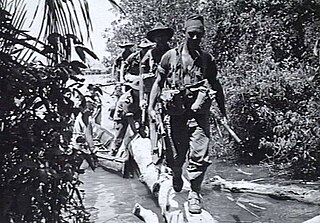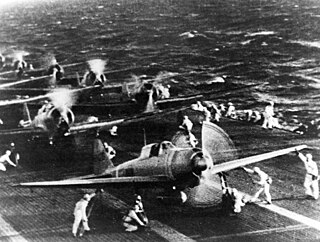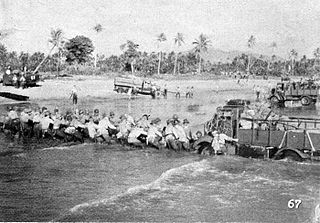
The Southern Expeditionary Army was an army group of the Imperial Japanese Army during World War II. It was responsible for all military operations in South East Asian and South West Pacific campaigns of World War II. Its military symbol was NA.
The Asiatic-Pacific Theater was the theater of operations of U.S. forces during World War II in the Pacific War during 1941–45. From mid-1942 until the end of the war in 1945, there were two U.S. operational commands in the Pacific. The Pacific Ocean Areas (POA), divided into the Central Pacific Area, the North Pacific Area and the South Pacific Area, were commanded by Admiral Chester W. Nimitz, Commander-in-Chief Pacific Ocean Areas. The South West Pacific Area (SWPA) was commanded by General Douglas MacArthur, Supreme Allied Commander South West Pacific Area. During 1945, the United States added the United States Strategic Air Forces in the Pacific, commanded by General Carl A. Spaatz.

The Battle of the Java Sea was a decisive naval battle of the Pacific campaign of World War II.

John Bernard "Jack" Mackey, VC was an Australian recipient of the Victoria Cross, the highest award for gallantry in the face of the enemy that can be awarded to British Commonwealth forces. Mackey was one of twenty Australians to receive the award for actions during the Second World War, receiving his award posthumously for leading an attack on against a strongly defended Japanese position during the Battle of Tarakan in May 1945. He was 22 and serving as a corporal in the 2/3rd Pioneer Battalion at the time of his death.

The Battle of Makassar Strait, also known as the Action of Madura Strait, the Action North of Lombok Strait and the Battle of the Flores Sea, was a naval battle of the Pacific theater of World War II. An American-British-Dutch-Australian (ABDA) fleet—under Schout-bij-nacht Karel Doorman—was on its way to intercept a Japanese invasion convoy reported as bound for Surabaya, when it was attacked by 36 Mitsubishi G4M1 "Betty" and 24 Mitsubishi G3M2 "Nell" medium bombers, which forced the fleet to retreat.

The Australian First Tactical Air Force was formed on 25 October 1944 by the Royal Australian Air Force (RAAF). Its purpose was to provide a mobile force of fighter and ground attack aircraft that could support Allied army and naval units fighting the Empire of Japan in the South West Pacific Area. One of several Allied tactical air forces formed during World War II, it evolved from the RAAF's No. 10 Operational Group, established a year earlier. Following action in the assaults on Aitape and Noemfoor, the group was renamed the First Tactical Air Force to better reflect its size and role. It was beset with morale and leadership issues in early 1945, but recovered to take part in the battles of Tarakan, North Borneo, and Balikpapan. Reaching its peak strength of over 25,000 personnel in July 1945, No. 1 TAF's squadrons operated such aircraft as the P-40 Kittyhawk, Supermarine Spitfire, Bristol Beaufighter, and B-24 Liberator. The formation remained active following the end of hostilities in the Pacific until it was disbanded on 24 July 1946.

The Borneo campaign of 1945 was the last major Allied campaign in the South West Pacific Area during World War II to liberate Japanese-held British Borneo and Dutch Borneo. Designated collectively as Operation Oboe, a series of amphibious assaults between 1 May and 21 July were conducted by the Australian I Corps, under Lieutenant-General Leslie Morshead, against Imperial Japanese forces who had been occupying the island since late 1941 – early 1942. The main Japanese formation on the island was the Thirty-Seventh Army under Lieutenant-General Masao Baba, while the naval garrison was commanded by Vice-Admiral Michiaki Kamada. The Australian ground forces were supported by US and other Allied air and naval forces, with the US providing the bulk of the shipping and logistic support necessary to conduct the operation. The campaign was initially planned to involve six stages, but eventually landings were undertaken at four locations: Tarakan, Labuan, North Borneo and Balikpapan. Guerilla operations were also carried out by Dayak tribesmen and small numbers of Allied personnel in the interior of the island. While major combat operations were concluded by mid-July, mopping-up operations continued throughout Borneo until the end of the war in August. Initially intended to secure vital airfields and port facilities to support future operations, preparatory bombardment resulted in heavy damage to the island's infrastructure, including its oil production facilities. As a result, the strategic benefits the Allies gained from the campaign were negligible.

The Battle of Tarakan was the first stage in the Borneo campaign of 1945. It began with an amphibious landing by Allied forces on 1 May, code-named Operation Oboe One; the Allied ground forces were drawn mainly from the Australian 26th Brigade, but included a small element of Netherlands East Indies personnel. The main objective of the landing was capture of the island's airfield. While the battle ended with success for the Allied forces over the Japanese defenders, this victory is generally regarded as having not justified its costs. The airfield was so heavily damaged that it ultimately could not be repaired in time to make it operational for other phases of the Allied campaign in Borneo.

The Battle of North Borneo took place during the Second World War between Allied and Japanese forces. Part of the wider Borneo campaign of the Pacific War, it was fought between 10 June and 15 August 1945 in North Borneo. The battle involved a series of amphibious landings by Australian forces on various points on the mainland around Brunei Bay and upon islands situated around the bay. Japanese opposition to the landings was sporadic initially, although as the campaign progressed a number of considerable clashes occurred and both sides suffered significant casualties, although major combat was largely restricted to Labuan and around Beaufort. On the mainland, while Allied conventional operations focused largely on the coastal areas around Brunei Bay, guerrilla forces consisting of Dayak tribesmen and small numbers of Allied personnel from the Services Reconnaissance Department fought an unconventional campaign in the interior. The Allies were successful in seizing control of the region. Nevertheless, many of the strategic gains that possession of North Borneo provided were ultimately negated by the sudden conclusion of the war in August 1945.

The South West Pacific theatre, during World War II, was a major theatre of the war between the Allies and the Axis. It included the Philippines, the Dutch East Indies, Borneo, Australia and its mandate Territory of New Guinea and the western part of the Solomon Islands. This area was defined by the Allied powers' South West Pacific Area (SWPA) command.

The Pacific Ocean theater, during World War II, was a major theater of the war between the Allies and the Empire of Japan. It was defined by the Allied powers' Pacific Ocean Area command, which included most of the Pacific Ocean and its islands, while mainland Asia was excluded, as were the Philippines, the Dutch East Indies, Borneo, Australia, most of the Territory of New Guinea and the western part of the Solomon Islands.

The Dutch East Indies campaign of 1941–1942 was the conquest of the Dutch East Indies by forces from the Empire of Japan in the early days of the Pacific campaign of World War II. Forces from the Allies attempted unsuccessfully to defend the islands. The East Indies were targeted by the Japanese for their rich oil resources which would become a vital asset during the war. The campaign and subsequent three and a half year Japanese occupation was also a major factor in the end of Dutch colonial rule in the region.
This article concerns the naval and land battles of Balikpapan in 1942. For information on the 1945 landings by Australian forces in the same area, see Second Battle of Balikpapan.

Juwata International Airport is an international airport in Tarakan, North Kalimantan, Indonesia. It is located on the island of Tarakan which is off the coast of Borneo. The airport was the main Allied objective during the Battle of Tarakan (1945). The airport is planned to be a transit hub for people from other countries such as Malaysia, Brunei and Philippines who is going to travel to other cities in Indonesia.Juwata Airport is a destination point of the ASEAN Single Aviation Market under Protocol I and II.

Tarakan is an island and the largest city of the Indonesian province of North Kalimantan. The island city is located in northern Borneo, just across the border from Sabah, Malaysia. Once a major oil-producing region during the colonial period, Tarakan had great strategic importance during the Pacific War and was among the first Japanese targets early in the war. It is the sole city within the newly established Indonesian province of North Kalimantan. According to Statistics Indonesia, the city had a population of 253,026 inhabitants as of 2017.
The 2/9th Cavalry (Commando) Regiment was one of three commando regiments raised by the Australian Army for service during World War II. It was originally raised in 1940 as an armoured cavalry unit as part of the 8th Division, before being transferred to the 9th Division. Between 1941 and 1942 the regiment saw action in the Middle East before being returned to Australia in early 1943. At this time the regiment was re-organised as the administrative headquarters for the 2/4th, 2/11th and 2/12th Commando Squadrons and it was converted into a commando regiment. Later in 1945 the unit saw action during the landings on Tarakan on Borneo before being disbanded upon the cessation of hostilities.

No. 77 Wing was a Royal Australian Air Force (RAAF) wing of World War II. It formed part of No. 10 Operational Group at its establishment in November 1943, when it comprised three squadrons equipped with Vultee Vengeance dive bombers. No. 77 Wing commenced operations in early 1944, flying out of Nadzab, Papua New Guinea. Soon afterwards, however, the Vengeance units were withdrawn from combat and replaced with squadrons flying Douglas Bostons, Bristol Beaufighters and Bristol Beauforts. The wing saw action in the assaults on Noemfoor, Tarakan, and North Borneo, by which time it was an all-Beaufighter formation made up of Nos. 22, 30 and 31 Squadrons. It was to have taken part in the Battle of Balikpapan in June 1945, but unsuitable landing grounds meant that the Beaufighter units were withdrawn to Morotai, sitting out the remainder of the war before returning to Australia, where they disbanded, along with the wing headquarters, in 1946.
The 2/3rd Pioneer Battalion was a pioneer battalion of the Australian Army, which served during World War II. Formed in 1940, the battalion served in the Middle East where it fought in Syria and Palestine before taking part in the fighting around El Alamein. In 1943, the battalion returned to Australia and subsequently took part in the fighting against the Japanese in New Guinea in 1943–1944. Their final campaign came in mid-1945, when they took part in the Battle of Tarakan during the Borneo campaign. The battalion was disbanded in early 1946.













